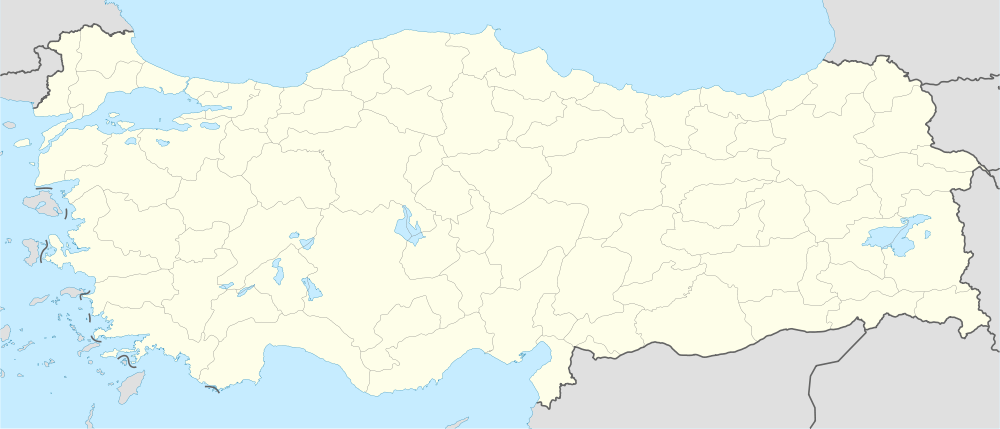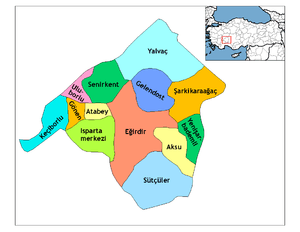Isparta
| Isparta | |
|---|---|
| Municipality | |
 Isparta | |
| Coordinates: 37°45′53″N 30°33′24″E / 37.76472°N 30.55667°ECoordinates: 37°45′53″N 30°33′24″E / 37.76472°N 30.55667°E | |
| Country | Turkey |
| Province | Isparta |
| District | Isparta |
| Government | |
| • Mayor | Yusuf Ziya Günaydın (MHP) |
| Area[1] | |
| • District | 682.41 km2 (263.48 sq mi) |
| Population (2012)[2] | |
| • Urban | 198,385 |
| • District | 219,904 |
| • District density | 320/km2 (830/sq mi) |
| Post code | 32000 |
| Website |
www |
Isparta (Greek: Σπάρτη, also Baris/Βάρις in Byzantine Greek) is a city in western Turkey and the capital of Isparta Province. The city's population was 222,556 in 2010 and its elevation is 1035 m. It is also known as the "City of Roses".
The main economic activities of Isparta are the production of rose water and handmade carpets. Tourism, both local and increasingly international due to "biblical tourism", is also becoming an important source of revenue for the city. Süleyman Demirel University has introduced thousands of youths from various backgrounds to the city's mostly conservative fabric in the recent years. The city's football team, Ispartaspor, currently plays in Group 7 of the Turkish Regional Amateur League.
Some historical buildings and houses remain from the 19th century, but are rare compared to the number of modern buildings. There are several important mosques in Isparta, including the pre-Ottoman Hızır Bey Mosque (c. 1325), the Kutlubey or Ulu (Grand) Mosque (1429, with major restorations made in the 19th century) and Hacı Abdi Mosque (1569). The city also boasts a mosque by the Ottoman Royal Architect Mimar Sinan - the 16th century's Firdevs Pasa mosque. This mosque is also known as Mimar Sinan Mosque. There are several remains of Greek Orthodox churches from the Byzantine and Ottoman periods (14th-19th century). The Byzantine fortress is mostly in ruins. The city lies close to a fault line and is thus prone to violent earthquakes.
Isparta is well-connected to other parts of Turkey via railways and roads. Antalya lies 130 km to the south and Eskişehir is 350 km to the north.
On November 30, 2007, Atlasjet Flight 4203 crashed on approach to Isparta Süleyman Demirel Airport, killing all 57 passengers and crew.
Climate
Isparta has a hot summer continental climate (Köppen climate classification: Dsa) with cold, snowy winters and hot, dry summers.
| Climate data for Isparta | |||||||||||||
|---|---|---|---|---|---|---|---|---|---|---|---|---|---|
| Month | Jan | Feb | Mar | Apr | May | Jun | Jul | Aug | Sep | Oct | Nov | Dec | Year |
| Record high °C (°F) | 17.6 (63.7) |
19.0 (66.2) |
26.8 (80.2) |
28.4 (83.1) |
32.0 (89.6) |
36.2 (97.2) |
42.3 (108.1) |
41.2 (106.2) |
35.6 (96.1) |
31.0 (87.8) |
25.4 (77.7) |
20.0 (68) |
42.3 (108.1) |
| Average high °C (°F) | 6.4 (43.5) |
7.6 (45.7) |
11.7 (53.1) |
16.5 (61.7) |
21.7 (71.1) |
26.6 (79.9) |
30.4 (86.7) |
30.5 (86.9) |
26.5 (79.7) |
20.5 (68.9) |
13.9 (57) |
8.1 (46.6) |
18.37 (65.07) |
| Average low °C (°F) | −2.0 (28.4) |
−1.4 (29.5) |
0.9 (33.6) |
4.7 (40.5) |
8.4 (47.1) |
12.3 (54.1) |
15.3 (59.5) |
14.9 (58.8) |
10.6 (51.1) |
6.5 (43.7) |
2.2 (36) |
−0.4 (31.3) |
6 (42.8) |
| Record low °C (°F) | −19.2 (−2.6) |
−21.0 (−5.8) |
−18.5 (−1.3) |
−7.7 (18.1) |
−1.2 (29.8) |
4.5 (40.1) |
4.9 (40.8) |
7.0 (44.6) |
−0.8 (30.6) |
−4.2 (24.4) |
−11.5 (11.3) |
−15.0 (5) |
−21 (−5.8) |
| Average precipitation mm (inches) | 72.7 (2.862) |
64.8 (2.551) |
54.3 (2.138) |
56.1 (2.209) |
50.1 (1.972) |
29.5 (1.161) |
13.5 (0.531) |
10.5 (0.413) |
15.6 (0.614) |
36.4 (1.433) |
46.1 (1.815) |
85.6 (3.37) |
535.2 (21.069) |
| Avg. rainy days | 8 | 9 | 7 | 7 | 7 | 5 | 2 | 1 | 3 | 5 | 5 | 9 | 68 |
| Mean monthly sunshine hours | 120.9 | 134.4 | 186 | 207 | 269.7 | 324 | 359.6 | 347.2 | 291 | 220.1 | 156 | 102.3 | 2,718.2 |
| Source #1: Devlet Meteoroloji İşleri Genel Müdürlüğü [3] | |||||||||||||
| Source #2: Hong Kong Observatory [4] | |||||||||||||
History of the city
Isparta corresponds to the ancient city of Baris, which was part of the Roman province of Pisidia. At an early stage it became a Christian bishopric, a suffragan of the metropolitan see of Antioch of Pisidia, the capital of the province. The names of two of its bishops are known with certainty: Heraclius participated in the First Council of Nicaea in 325, and Leo in the Second Council of Nicaea in 787. In addition, Paulus was at the Council of Constantinople (869) and Stephanus was at the Council of Constantinople (879), but one or both of these may have been of the Baris in the Roman province of Hellespontus.[5][6] No longer a residential bishopric, Baris in Pisidi is today listed by the Catholic Church as a titular see.[7]
- 1203: Occupied by the Seljuqs.
- Late 13th century: Becomes part of the Hamidids.
- 1381: Isparta is sold to the Ottoman sultan Murad I by the Hamidid Emir.
- Late 19th century: Muslim refugees from the Balkans settle around Isparta. The Bulgarian refugees brought the knowledge of rosewater production with them.
Economy
In the early 20th century carpetmaking was a major industry in Isparta.[8]
People from and related to Isparta
- Zeki Demirkubuz, film director, screenwriter, producer and film editor.
- Süleyman Demirel, former prime minister and president of Turkey, was born in the village of Islamköy close to Isparta.
- Said Nursî, Islamic thinker. Spent the last decade of his life in this city.
- Bora Maviş, summiter of Mount Everest.
- Mustafa Doğan, footballer.
- Hussein Avni Pasha, Ottoman Grand Vizier
- Halil Hamid Pasha, Ottoman Grand Vizier
International relations
Twin towns — Sister cities
Isparta is twinned with:
See also
References
- ↑ "Area of regions (including lakes), km²". Regional Statistics Database. Turkish Statistical Institute. 2002. Retrieved 2013-03-05.
- ↑ "Population of province/district centers and towns/villages by districts - 2012". Address Based Population Registration System (ABPRS) Database. Turkish Statistical Institute. Retrieved 2013-02-27.
- ↑ İl ve İlçelerimize Ait İstatistiki Veriler- Meteoroloji Genel Müdürlüğü
- ↑ Climatological Normals of Isparta
- ↑ Michel Lequien, Oriens christianus in quatuor Patriarchatus digestus, Paris 1740, Vol. I, coll. 1049-1050
- ↑ Raymond Janin, v. 2. Baris, in Dictionnaire d'Histoire et de Géographie ecclésiastiques, vol. VI, 1932, col. 808
- ↑ Annuario Pontificio 2013 (Libreria Editrice Vaticana 2013 ISBN 978-88-209-9070-1), p. 847
- ↑ Prothero, G. W. (1920). Anatolia. London: H.M. Stationery Office. p. 110.
External links
| Wikisource has the text of the 1911 Encyclopædia Britannica article Izbarta. |
- Hunt for clues in Turkish crash
- Sav Kasabası, village in Isparta turkce
- Sav Kasabası, village in Isparta english
- Isparta City Portal - All about Isparta
